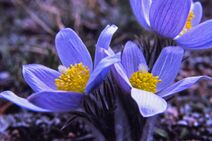Pulsatilla patens
| Pulsatilla patens | |
 | |
| Light: | |
| Moisture: | |
| Hardiness: | 4 |
| Soil pH: | 5.6-8.4 |
| Self Pollinated | |
| Height: | 2' |
| Blooms: | Early Spring-Late Spring |
| Native to: | |
| Medicinal Rating: | |
| Tea: | Yes |
Pulsatilla patens (common names: pasque flower and eastern pasqueflower)
Propagation: Seed - best sown as soon as it is ripe in early summer in a cold frame. The seed usually germinates in about 2 - 3 weeks. Sow stored seed in late winter in a cold frame. Germination takes about 1 - 6 months at 15°c. When they are large enough to handle, prick the seedlings out into individual pots and grow them on in the greenhouse for at least their first winter. Plant them out into their permanent positions in the spring.
Root cuttings, 4cm long taken in early winter, potted up in a mixture of peat and sand[1]. They can also be taken in July/August, planted vertically in pots in a greenhouse or frame.
Cultivation: Requires a well-drained humus-rich gritty soil and a sunny position[2]. Lime tolerant[3][2].
A very ornamental plant[3].
Large plants transplant badly[2].
A greedy plant, inhibiting the growth of nearby plants, especially legumes[4].
Range: N. Europe to Siberia.
Habitat: Sparse pine forests and dry sunny slopes[5]. Grassy slopes, mountain slopes under forests at around 1100 metres in northern China[6].
Medicinal: Appetizer, digestive, diuretic, emmenagogue, expectorant, stimulant[7][8][9].
Use of the plant lessens sexual excitement. It does not diminish sexual power but rather strengthens it by lessening morbid excitement[8].
A drug derived from the chopped whole plant induces vomiting and irritation of the kidneys[9]. In high doses it acts as a depressant on the central nervous system and the heart[9].
A decoction of the plant has been used to speed delivery of a child[10].
A poultice of the fresh crushed leaves has been applied in the treatment of rheumatism and neuralgia[10].
A volatile oil contained in the plant is used as an irritant[11].
Pollinators: Bees
Soil: Can grow in light and medium soils.
Drainage: Prefers well drained soil.
Flower Type: Hermaphrodite
Known Hazards: Although no mention has been seen for this species, at least one member of the genus is slightly toxic, the toxins being dissipated by heat or by drying the plant[12].
Also Known As: Anemone patens. L.
Links
References
- ↑ Bird, Alfred. Focus on Plants Volume 5. Thompson and Morgan, 1991.
- ↑ 2.0 2.1 2.2 Huxley, Anthony. The New Royal Horticultural Society Dictionary of Gardening. MacMillan Press, 1992.
- ↑ 3.0 3.1 Chittendon, Fred. RHS Dictionary of Plants. Oxford University Press, 1951.
- ↑ Hatfield, Audrey. How to Enjoy your Weeds. Frederick Muller Ltd, 1974.
- ↑ Komarov, Vladimir. Flora of the USSR. Gantner Verlag, 1968.
- ↑ Flora of China. 1994.
- ↑ Usher, George. A Dictionary of Plants Used by Man. Constable, 1974.
- ↑ 8.0 8.1 Coffey, Timothy. The History and Folklore of North American Wild Flowers. Facts on File, 1993.
- ↑ 9.0 9.1 9.2 Weiner, Michael. Earth Medicine, Earth Food. Ballantine Books, 1980.
- ↑ 10.0 10.1 Moerman, Daniel. Native American Ethnobotany. Timber Press, 1998.
- ↑ Davis, Ray and Frank Craighead. A Field Guide to Rocky Mountain Wildflowers. The Riverside Press, 1963.
- ↑ Frohne, Dietrich and Hans Pfänder. J. A Colour Atlas of Poisonous Plants. Timber Press, 1984.